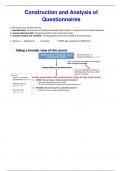Summary
Construction and Analysis of Questionnaires: Summary of all lectures including examples and tips
- Course
- Institution
This is a summary including all lecture notes and chapter notes needed for the course MAW-INT: Construction and Analysis of Questionnaires. The course is part of the study program for second year Bachelor students of the HR, GMSI and Sociology studies.
[Show more]



